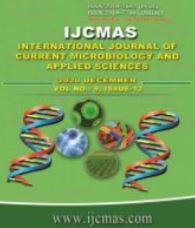


 National Academy of Agricultural Sciences (NAAS)
National Academy of Agricultural Sciences (NAAS)

|
PRINT ISSN : 2319-7692
Online ISSN : 2319-7706 Issues : 12 per year Publisher : Excellent Publishers Email : editorijcmas@gmail.com / submit@ijcmas.com Editor-in-chief: Dr.M.Prakash Index Copernicus ICV 2018: 95.39 NAAS RATING 2020: 5.38 |
The present study entitled Comparative economics of farm ponds beneficiary and non-beneficiary farmers in Akola tahasil. A farm pond is a large hole dug out in the earth, usually square or rectangular in shape, which harvests rainwater and stores it for future use. Economic evaluation of farm pond is necessary for the effective implementation. The main objective of present study was to assess the impact of farm ponds on productivity of various inputs used by farmers. This study was undertaken in Akola tahasil. The study was based on a sample of 60 beneficiary and 60 non-beneficiary farmers data pertaining the year 2017-18 were collected by survey method from the beneficiary and non-beneficiary farmers. The sample farmers were personally contacted and primary data was collected from them in a specially structured schedule i.e., cost ‘A’, cost ‘B’ and cost ‘C’ was used for the analysis of data. It is observed from the study that output-input ratio of beneficiary farmers was higher as compare to non-beneficiary farmers. It shows that the beneficiary farmers were more profitable than non-beneficiary farmers.
 |
 |
 |
 |
 |